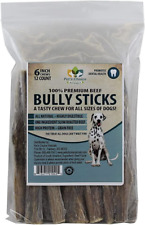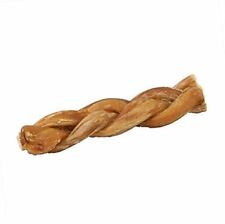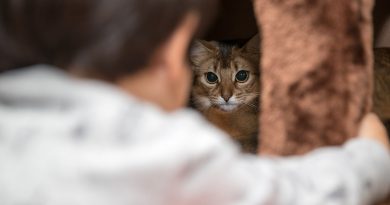The Health of Older Cats

Vaccinations (Innoculations)
Keep Cat Flu (Calicivirus) and Feline Infectious Enteritis (Distemper) vaccinations up to date as your cat ages. It is tempting to let these lapse, but older cats have less efficient immune systems. If an adopted oldie hasn’t been vaccinated, or you aren’t sure about this, you can start vaccinations at any age. Depending on where you live, vaccinations are available for Cat Flu, Enteritis (Distemper), FeLV, Chlamydia, FIP and Rabies. Your vet will advise on which are required in your area.
Rabies is an acute viral infection of the central nervous system and is found in America and mainland Europe, but not in the UK, Hawaii, Australia, new Zealand and several other declared rabies-free states. It is spread by saliva e.g. bites or saliva entering broken skin. Wild animals such as bats, raccoons, skunks and foxes may carry it. After being bitten by a carrier, it takes 4-8 weeks for your cat to show symptoms. He will act oddly and may become restless or excitable or reclusive. He will later go into body spasms, may become aggressive (cats more often become withdrawn) and even paralyzed. Where rabies is prevalent cats require a rabies vaccination at 3 – 6 months of age with annual boosters. Rabies is incurable and dangerous to humans so a rabid cat must be destroyed. A cat which has been bitten by a potentially (unconfirmed) rabid creature must be specially quarantined for observation to see if he develops the disease.
Parasites
The most common skin parasite of cats are fleas. Indoor/outdoor cats may also pick up ticks. Fleas and ticks are more problematical to older cats and may cause anemia and skin problems as his body is slower to repair itself. Many cats suffer an itchy reaction to flea bites. Use a flea spray or flea powder formulated specifically for use on cats and in accordance with manufacturer’s instructions. Flea collars are convenient, but less effective, and must be elasticated for his safety; some cats are allergic to them. Skin-drops (on the back of the neck) and food additives are available with the drawback that the flea must bite the cat in order to be zapped. Treat the surroundings as well, but never use an environmental product on your cat as environmental flea sprays are highly toxic if applied directly to the cat.
Tapeworms, roundworms and other internal parasites affect older cats as well as young cats, particularly cats which go outdoors. If he goes outdoors, treat him for worms, especially roundworms, every 3 to 6 months. Indoor-only cats may require less frequent treatment. Information about cat parasites specific can be found in most cat books and your vet will tell you of parasites common in your area. Vets consider that most healthy cats can tolerate some internal parasites (often with no symptoms), though older cats may suffer anemia, lethargy and malnutrition due to their less efficient digestive systems.
Upper Digestive Tract – Vomiting
Cats sometimes regurgitate their food, especially if they bolted it or scavenged something indigestible. Vomiting (throwing up, puking) is the forceful expulsion of stomach contents. Regurgitation is usually voluntary and less violent. Some cats eat grass to trigger vomiting. Cats, especially longhairs, regurgitate hairballs unless groomed regularly. Unexplained vomiting which lasts for more than 24 hours or is accompanied by diarrhea or other symptoms must be investigated. Vomiting may be a symptom of disease, injury or poisoning. Vomiting and/or diarrhea can lead to dehydration if left untreated.
Many owners see their cat eating grass and expect it to vomit soon after. Grass is a purgative, but is also eaten for reasons -additional roughage, a natural nutrient supplement, it tastes good. Make sure the grass your cat eats is free of chemicals. Indoor cats require a pot or tray of grass, those with no access to grass may eat houseplants, many of which are toxic. Spider-plants (chlorophytum) are a favorite because they are grass-like. Chlorophytum itself is non-toxic, but can absorb environmental toxins.
You may know what has caused the vomiting and decide it is no cause for alarm. If the vomit contains white worms (roundworms), the cat should be wormed. Other common causes include change of diet, rich food, overeating, bolting food, hairballs, spoiled food, eating non-food items, poisoning, viral or bacterial infection and over-excitement. Frequent committing may be due to stomach ulcers, kidney or liver disease, diabetes, various types of cancer. Some cats have a hereditary condition of the esophagus (food-pipe) or cardiac sphincter (valve at top of the stomach which usually prevents regurgitation); these conditions can worsen with age and are usually treated by placing the cat’s food bowl on a chest-height stand so the cat eats standing up.
It the cause is a simple stomach upset, withhold food for the remainder of the day to allow his stomach to settle, but provide plenty of water. Provide small portions of bland food for the next few days or until he is visibly recovered. If the vomiting is due to food intolerances; try a different variety or different brand. Organic cat foods (e.g. Yarrah) or ones without artificial additives may help. A Selected Protein prescription diet may be required. If preservatives are the cause, a fresh meat diet with nutritional supplements may be required. Non-preservative usually have a shorter shelf life. If vomiting is due to eating inappropriate items, you must restrict access to these items!
Vomiting convulsions place a great strain on an elderly cat’s system, using up energy and causing muscle strain. Continued vomiting causes serious dehydration. In brain experiments, scientists forced cats to retch or vomit continuously; the cats died from exhaustion and dehydration in under 24 hours. If your cat vomits, provide clean, fresh water so it can rehydrate. If he is under veterinary supervision or convalescing, the vet may recommend you provide an electrolyte drink (e.g. Lectade) or may use intravenous rehydration/feeding to reduce the strain on its stomach.
Occasional vomiting and regurgitation is normal, but continued or repeated vomiting or regurgitation is a sign of an underlying or more serious problem. If you suspect the vomiting is not simply indigestion or hairballs, visit the vet promptly. The earlier the cause is diagnosed, the more successful the treatment is likely to be. Visit the vet promptly if your vomiting cat has diarrhea, is lethargic, won’t eat or drink, or the vomit contains blood.
Lower Digestive Tract – Bowel
What goes in must come out so keep an eye on your cat’s litter tray or toileting area and learn what is ‘normal’ for your cat. Some cats produce softer stools than others. Some foods may cause looser or firmer stools, but be alert for signs of worms, constipation, diarrhea or bloodstained stools and take him to the vet if you see anything abnormal.
Diarrhea (watery stools) occurs when the large intestine doesn’t reabsorb liquid from digested food. This may the body rushing through waste matter (e.g. in cases of infection) or a malfunction of the gut. The most common cause is dietary upset or milk intolerance. A change of diet, internal parasites, antibiotics and steroids can also cause diarrhea. Most of these causes are easily treated though it takes time for the cat’s system to settle back down to normal.
Diarrhea causes dehydration. If it persists for 48 hours or is bloody or your cat is also vomiting then see the vet. If your cat is seriously dehydrated, the vet will inject fluids subcutaneously (under the skin) or into the abdomen (peritoneally). If the cat continues to lose fluid, he may be put on an intravenous drip at the clinic. American owners are recommended to take a stool sample (and a urine sample, if possible) from a sick cat to the vet, but this is not the norm in the UK where the cat may be kept in for overnight observation instead. In the US, the vet may take a blood sample for analysis; in the UK the cat will probably stay in overnight for this. It is harder to get a stool sample from a cat which toilets outdoors.
White or cream colored stools may indicate liver and pancreas disorders or be the result of a recent barium meal/enema used by the vet to investigate a gut problem. A few smears of blood may reveal a rectal disorder (like haemorrhoids caused by straining) but dark blood or lots of blood in the stool indicates bleeding inside the gut and is far more serious. Inflammatory Bowel Disease (IBD) is more common in older cats and can cause liquid "cowpat-like" stools as the bowel no longer absorbs liquid.
Constipation happens when stools move too slowly through the gut or come to a complete halt, clogging up the gut. Constipated cats strain and have tender bellies. The commonest causes are hairballs, too little fiber in the diet (dried food is convenient for the owner, but produces small, hard stools which do not give the gut a good workout) or it may be due to an intestinal disorder. A cat laxative (e.g. Katalax) or liquid paraffin resolves most cases, but sometimes an enema or even surgery is required – especially if the blockage is due to a foreign body in the gut. Do not try to give your cat an enema at home – you could cause damage to his gut and he will almost certainly resist violently. Sedation is usually required.
Constipation is a common ailments of older cats. Bulk-forming agents, such as wheat bran, or other sources of fiber mixed with commercial cat food can help prevent hairballs and other blockages. Sometimes, surgical removal of the obstruction is necessary. Laxatives and hairball medications should not be used more than once a week unless recommended by a veterinarian, because they interfere with absorption of vitamins. Frequent constipation requires veterinary investigation. Some cats need their bowels expressed manually due to nerve damage.
Faecal incontinence (loss of bowel control) may be due to problems with the anal sphincter/rectal muscles or due to degenerative spinal or nerve problems. Amputation of the whole tail can reduce control of the rectum (tail muscles help squeeze out the contents of the rectum). Stools may be passed as the cat changes position or walks. If the involuntary motions are watery or soft, a bulking agent may produce firmer stools which the cat can control better. Some problems can be surgically treated, but if the problem is degenerative it will get worse, the cat may suffer paralysis of hindquarters and euthanasia may be required.
Urinary System
Older cats drink more water, but dramatically increased thirst indicates kidney problems, cystitis (inflamed bladder) or urethritis (inflamed "pee-pipe"). Kidney problems are more common in older cats as their kidneys work less efficiently (this is discussed elsewhere). Cats with cystitis pass frequent tiny amounts of urine, sometimes bloodstained or containing mucus (slime). Cystitis causes discomfort and must be treated by a vet. There are other reasons a cat might start to drink more so any unexplained increased thirst must be investigated by a vet. Make sure your cat has plenty to drink at all times – this keeps the urine dilute and prevents dehydration. If he doesn’t drink water often, flavor the water with a little tuna juice or meat gravy. Canned food has a higher liquid content.
"Feline Lower Urinary Tract Disorder" (FLUTD) or "Feline Urological Syndrome" (FUS) is a general name for non-kidney urinary problems. FLUTD is more common in older cats. There is no single cause, but many contributory factors including diet, stress and a hormonal link. Symptoms and causes include cystitis, urethritis, tumor in the bladder/urethra, bacterial infection, injury to the bladder/urethra or kidney stones, bladder stones or "gravel" in the urine. Stones and gravel are less common than they once were – they were associated with dried cat foods, but modern formulations eliminate the problem in all but a very few susceptible cats. Stones are a build up of crystals or mineral deposits; either calcium oxalate or struvite, depending on urine pH. Urethral plugs are soft plugs of accumulated material containing minerals, blood, cellular debris and protein, blocking or partially blocking your cat’s urethra ("pee-pipe").
If your cat has problems urinating or urinates every few minutes, see the vet at once. If he can’t urinate at all, the kidneys can’t function, infection sets in and he may die in 36-48 hours from blood toxicity or the pH of the blood changing. The vet will remove obvious blockages and may drain and flush out the bladder using a catheter. Rehydration and antibiotics/anti-inflammatories may be required. In male cats, frequent blockage can be surgically corrected by widening the urethra. The vet will probably prescribe a high-energy, low ash content food with reduced magnesium, calcium and phosphorous and ingredients to adjust the pH of the urine and prevent further problems.
Urinary incontinence (loss of bladder control) occurs in older cats if the bladder sphincter doesn’t work properly or the bladder doesn’t send "full up" signals in time for the cat to reach his litter tray. He may dribble after urination (sphincter doesn’t shut off the flow), at times throughout the day (sphincter cannot fully hold back the urine) or when asleep (sphincter relaxes). It may also be caused by injury to certain nerves or to the brain. Stress incontinence (when coughing/sneezing) may be due to an infection which requires antibiotic treatment. Urinary incontinence is involuntary and should not be confused with house-soiling in senile cats or scent-marking (a behavioral problem).
Medication, hormone therapy or surgery may resolve the problem, but an immediate concern is keeping him dry and comfortable or he will suffer urine burns from sitting or lying in urine. Various types of bedding allow urine to seep through a stay-dry top layer into a washable absorbent layer. Stud-pants (a sort of diaper used for breeding male cats which spray) help if the cat tolerates wearing them. A low stress environment and several litter-boxes may reduce the problem by allowing him to quickly reach his toilet.
Surgery
Cats sometimes need surgery. If pre-anesthetic blood tests show mild liver or kidney problems, your vet may suggest feeding an appropriate prescription food for a few weeks before surgery to further reduce any risks. Before surgery your cat will be given a pre-med injection. He will be anaesthetized by injection and kept under using a gas anesthetic. His pulse and breathing are monitored during the operation, just as for a human operation, and he may be given intravenous fluids during, and after, his operation. Heated pads are used during and after operations to keep him warm and he will be given pain-relief.
After returning home, he should be kept warm and quiet for a few days and may sleep off the effects of the operation. Your vet may provided painkillers since human painkillers are poisonous to cats. Your vet will give more detailed information on post-operative care and on going back for a check-up. Your cat will usually let you know when he feels fully recovered, but always follow your vet’s advice and contact him if you notice any problems or have any concerns.
Older Cat Clinics
As cats grow older, they become less resilient to illness or injury and recover more slowly. They may develop stiffer joints and a more relaxed pace of life to compensate. Cats are generally healthy creatures and fairly low-maintenance even as they age., but when they are unwell they tend to hide their symptoms. Many vets run "Older Cat Clinics" and recommend that cats over 5 years old have a veterinary check-up every 6-12 months (equivalent to 2-3 years in humans!) so that problems can be caught and treated early. A benefit of "Older Cat Clinics" is that you can meet other owners of older cats and compare notes. Annual vaccination time is another opportunity for a health-check.
In the US, a full health-check may include physical examination, weighing, checking stool sample, urine sample, blood sample and possibly tissue biopsies, X-rays or ultrasound scans. In the UK (due to the indoor/outdoor lifestyle and toileting outdoors rather than in litter trays) collecting samples would require an overnight stay at the vet clinic and are not done routinely due to the stress of hospitalization – your observations are therefore important.
Cats nowadays live much longer than in the past, and the fact that some ailments are more common in older cats doesn’t mean that your cat will necessarily develop them. A great many cats reach their teens and twenties with little or no sign of deterioration. The following symptoms are worth reporting to your vet as they help him to make an early diagnosis of a problem before that problem becomes serious. Remember: prompt diagnosis prolongs life.
When to Call the Vet
Sometimes your cat will need an unscheduled visit the vet. Most good cat care books contain information about ailments which can affect cats of all ages. Accidents including poisoning will mean and unscheduled emergency visit.
Many household and garden items are toxic to cats and are listed in cat care books. The list includes unexpected items such as chocolate and onion. Aspirin, other human medications, ethylene glycol (antifreeze) and slug pellets are seriously toxic to cats. Chemical poisons may burn the mouth and throat making the cat paw at its mouth and drool. Behavioral effects include lethargy, restlessness, anxiety, confusion.
Other symptoms include vomiting, staggering and collapse. Poisoning may be fatal or may cause sickness depending on the toxin, the quantity swallowed and the age, weight and health of the cat (this is why medical drugs have dosage per pound/kilo bodyweight). Making the cat vomit may cause more harm than good as the vomit may scald the throat and mouth. Seek emergency vet attention; if you know what the cat has eaten tell the vet and take with you any container to help the vet determine the best treatment.
The following symptoms in an older cat should be investigated by your vet:
- Evidence of poisoning or injury
- House-soiling
- Constipation or diarrhea despite a balanced diet
- Frequent urination or problems urinating
- Unexplained or frequent vomiting or regurgitation
- Excessive thirst
- Loss of appetite or excessive appetite
- Sudden loss of weight
- Change of activity level – suddenly hyperactive or lethargic
- Lumps and bumps on the cat’s skin
- Panting when at rest
- Rapid heartbeat
- Dental problems
- Looking off-color, withdrawn or not interested in things
- Unusual behavior, confusion
- Staggering or sudden collapse
- Mobility problems, stiffness, limping, pain when touched
Don’t delay in taking your cat to the vet if you are concerned about its health. Although the cause may turn out to be trivial, your vet would much rather declare your cat fit and healthy than have to tell you that an illness has progressed too far to be treatable. It is more effective to treat problems early on, ensuring a healthier, longer life. While at the vet clinic, your will give you cat a check-up and may note symptoms which you have missed.
Giving Medication
Not all tablets can be crushed into food and some cats simply cannot be pilled using conventional methods. I have owned cats which could not even be pilled by vets aided by a veterinary nurse! Ask if there is are alternatives e.g. liquid medication or injections. If not, you may have to accept that your cat will not live as long as a medicated cat and be prepared for euthanasia if or when he deteriorates.
Get the vet to demonstrate how to give a pill or refer to an illustrated cat book. You may need someone to restrain your cat or you may have to wrap him in a towel. Watch him to make sure he swallows the pill before releasing him and watch for a few minutes afterwards in case he regurgitates the pill. Feeding a kitty treat afterwards usually prevents regurgitation!
Other methods include a pill gun from the vet or pet store, placing the pill inside a hollow cat treat or mixing it with canned cat food. Cats often eat around the pill (they can smell it even if you can’t) so you must crush it thoroughly and mix it well in strong-smelling food to mask the smell and taste. Other methods I have found useful include putting the pill inside a piece of cooked sausage or a ball of cheese; if these foods are rare treats then the cat will eat it before you change your mind! I have also found crushing the pill and mixing the powder with a small amount of milk, water or gravy and spooning or syringing the liquid into the cat’s mouth to be useful as the cat instinctively swallows the liquid
Powdered medication can be mixed with strong smelling cat food. Sardines/pilchards in tomato sauce are ideal if your cat likes these. Otherwise you may have to mix the powder with liquid and syringe-feed it to your cat. Injections are given into a muscle or under the skin (subcutaneously). It is often easier to inject a cat than a human as the fur hides the sight of the needle going in. Ask your vet to teach you the technique. Skin is surprisingly hard to puncture and you will probably have to inject water into a number of oranges to learn how to get the speed and pressure right.
Pain and Pain Relief
Signs of pain include trembling, shivering and crouching. It may be hard for you to identify the source of the pain (especially if it is an internal problem) and cats may respond badly to your attempts to do so. Human painkillers such as aspirin, paracetamol, acetaminophen or ibuprofen are lethal to cats. Warm compresses may help if you can locate the source or already know the cause (e.g. arthritis). Warmth and sleep are great pain-relievers and a hot-water bottle wrapped in a fleece and placed in the cat’s bed may help. Unless the cause of pain has previously been diagnosed, see the vet promptly.
Learn to read your cat’s body language and learn what is normal for him when he is contented. That way you will more quickly recognize signs of illness, discomfort or distress. Cats in pain or distress often purr as a way of reassuring themselves; this confuses owners who recognize purring as a sign of all being well. Purring realizes endorphins (the body’s own pain killers and feel-good chemicals, actually very similar to opiates) to help reduce the pain.
Complementary Medicine and Treatment
Many owners like to use complementary (alternative) treatments and some vets are qualified in certain alternative therapies. Speak to your vet before giving homeopathic or herbal remedies as these may interact with prescription drugs, making them less effective or making your cat ill due to their combined action. Non-drug complementary treatments such as acupuncture, massage, Bach Flower Remedies, crystal therapy, faith-healing, prayer etc are usually safe. I have never known a cat suffer prayer-allergy. Some vets can refer you to acupuncturists or other complementary therapy practitioners. If you seek the practitioners yourself, it is still common courtesy to tell your vet. Some conventional treatments have complementary alternatives, some do not. I have successfully used Evening Primrose Oil long-term instead of corticosteroid treatment for feline skin problems.
Be careful about nutritional supplements as these can unbalance a balanced diet. Certain vitamins are toxic in large quantities or may accumulate to toxic levels in the liver or fatty tissues.
Insurance
Most serious injuries and diseases can be treated but surgery and medication may be expensive. Some may be prohibitively expensive if you don’t have a high income or plenty of savings. For this reason, a growing number of owners take out pet insurance. Policies differ, but most cover courses of treatment or one-off treatments (e.g. emergency surgery). Many insurance firms will not allow you to take out a policy on a cat aged over 10 years unless it has been insured previously. This deters some people from adopting older cats from shelters. Despite the apparently scary list of things which can go wrong, older cats are generally robust and healthy and the benefits of companionship outweigh any additional costs.
An alternative to pet insurance for veterinary bills is to arrange installment plans for paying veterinary bills. This must be arranged in advance will only be granted if you are already a good client (i.e. you always pay your bills) at that clinic.













